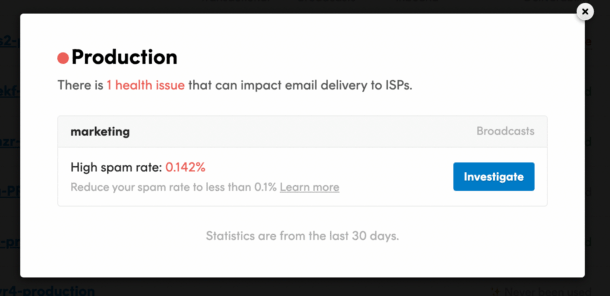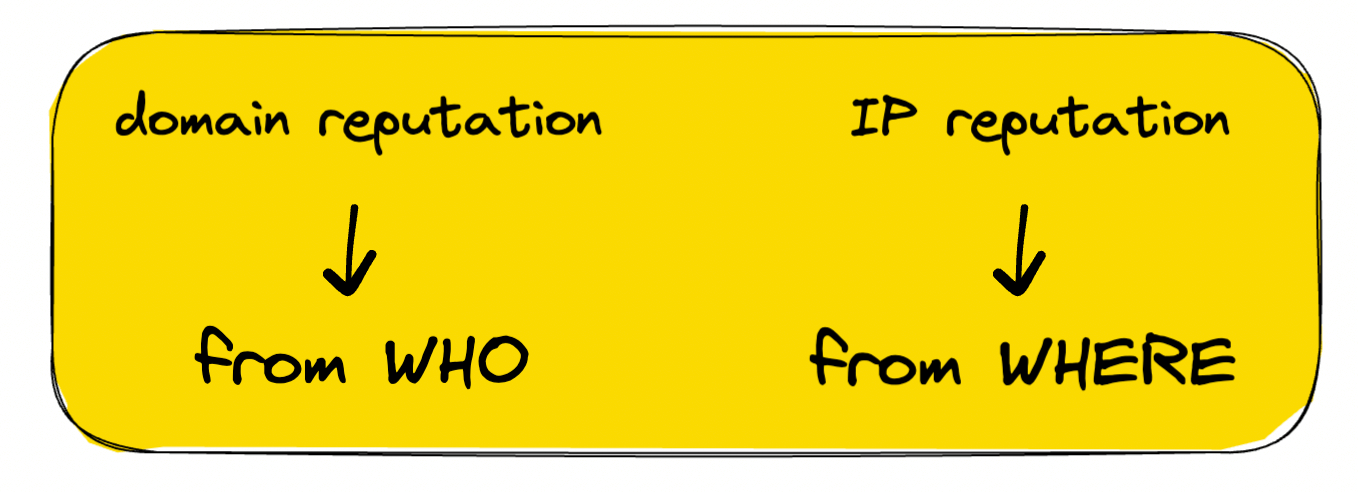Domain reputation is the opinion receivers—including mailbox providers and anti-spam services—have of your domain, which helps them decide if your emails should make it to a recipient’s inbox instead of being rejected or ending up in a spam folder.
Domain reputation is considered everywhere your domain is used, including:
- The address you’re sending email from (e.g. support@postmarkapp.com)
- The Return-Path Domain, which is the dedicated email address where bounces or non-delivery receipts are sent (e.g. pm_bounces@pm-bounces.postmarkapp.com)
- The DKIM Signing Domain, which is the domain used to decrypt the DKIM signature and authenticate your message (e.g. d=pm.mtasv.net)
- Any links, headers, content, and brand assets included in a message.
Although we talk about domain reputation in the singular, a domain has countless reputations, one per each receiver it comes into contact with—much like you have a unique reputation with everyone you know, based on things like how you’ve acted towards them in the past or who you’re associated with.
Each receiver keeps track of how the domain is used in a message and how that message performs in the recipients’ inbox, then uses a proprietary scoring algorithm to assign a reputation based on this information.
Why is domain reputation important? #
Domain reputation is your most valuable asset in email deliverability: its history determines your chance of getting emails to the inbox.
If you’ve ever sent shady or spammy content, or your content got low engagement rates, your domain will develop a bad reputation. In turn, this will affect overall deliverability, leading to:
- Decline in email open rates
- Customers complaining they are not receiving emails
- Valuable emails getting stuck in the spam folder
Switching to a new domain whenever you face a problem like this might look like a simple solution—but it isn’t 😉 An ‘unknown’ domain can raise a similar level of suspicion as a known ‘bad’ one. That’s why a good domain reputation is a valuable long-term investment and requires ongoing attention.
How to measure domain reputation
#
If you want to measure your reputation with an individual receiver... you probably can’t. Most receiver scoring algorithms are kept private, so spammers and other nefarious senders remain in the dark about how the system works (and cannot reverse-engineer it to their advantage).
- A notable exception is Google: you can check your domain reputation with Gmail recipients in Google Postmaster Tools (GPT), as long as you have a high-enough volume to anonymize the data.
If you want an overall measure of your domain reputation, you can use free domain reputation checkers and lookup tools like Talos Intelligence. These tools aggregate data from multiple receivers, looking at your track record when it comes to spam and your level of compliance with sender guidelines (if you want to dig deeper, check out this in-depth write-up with a few tools and methods for checking your domain reputation).
What causes a bad domain reputation & how to fix it #
A bad domain reputation can have several causes, from poor list management and poor engagement to abuse of your network/app.
Some providers (like Postmark 👋) might alert you to patterns that could affect your domain reputation, like high bounces or complaints, so you can take action quickly:

There are also some best practices to follow that can help you improve domain reputation, including:
- Targeting engaged recipients only to speed up reputation recovery
- Pruning your list of unengaged people who could hinder reputation recovery
- Reviewing your online forms & their security to prevent fraudulent sign-ups
- Keeping content super relevant and actionable to increase inbox placement and engagement
A solitary but very frequently asked question: #
What is the difference between domain and IP reputation? #
Domain reputation looks at who sent a message; IP reputation looks at where the message was sent from, i.e. the device or server corresponding to a specific IP address.
Providers want to protect customers from spammy or malicious content, and use IPs to determine the quality of a sending environment and make assumptions about the quality of a message, too.

Unlike your IP address, which you can change relatively easily, your domain sticks with you—which is why receivers are placing a lot more emphasis on domain reputation to determine your fate in the inbox.



